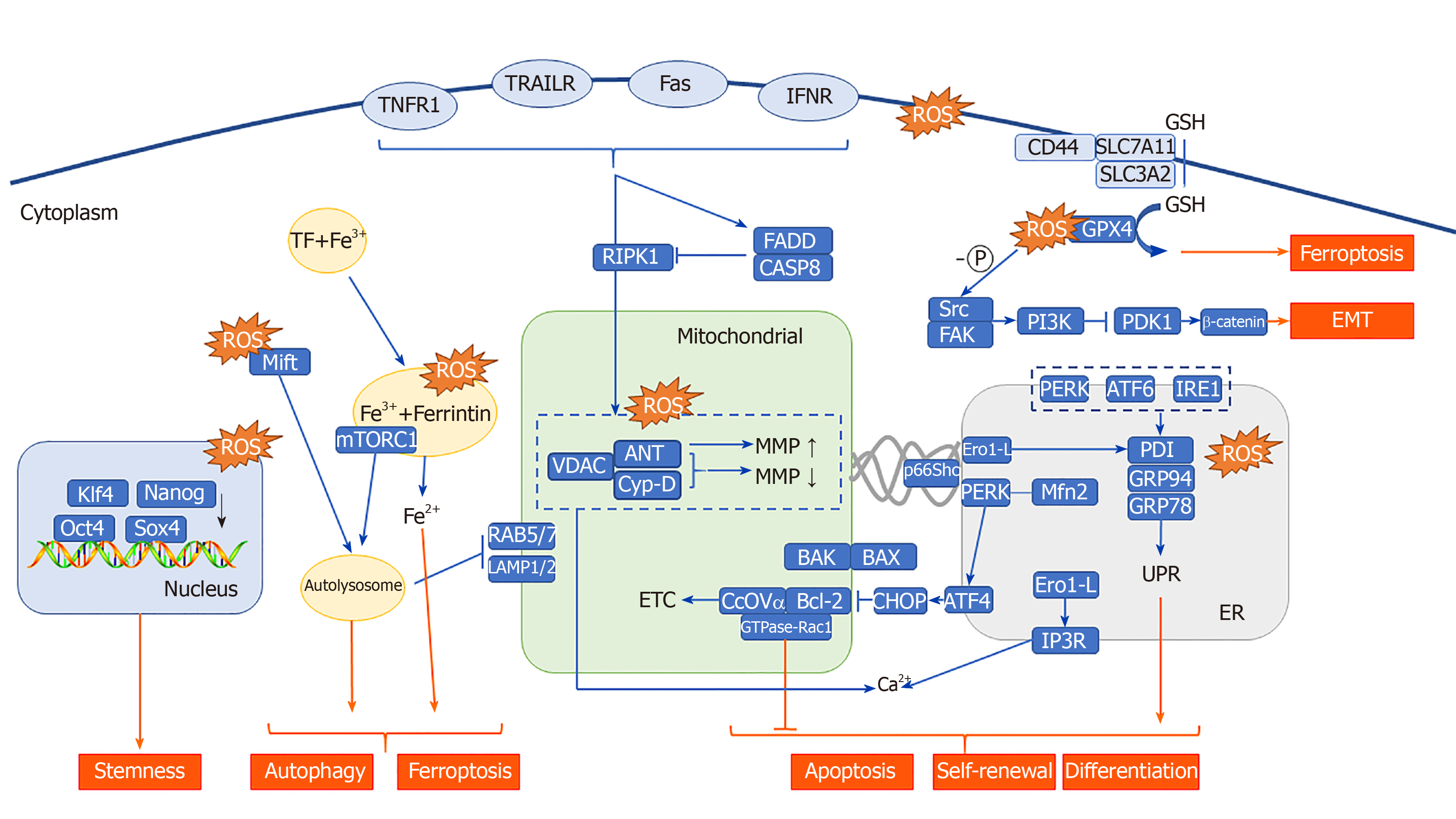Copyright
©The Author(s) 2020.
World J Stem Cells. Jul 26, 2020; 12(7): 562-584
Published online Jul 26, 2020. doi: 10.4252/wjsc.v12.i7.562
Published online Jul 26, 2020. doi: 10.4252/wjsc.v12.i7.562
Figure 1 The process of reactive oxygen species production and transformation in cancer stem cells.
A: The photosensitizer is activated from the ground singlet state to the excited singlet state and triplet state. The excited singlet state and triplet state can release energy through fluorescence and phosphorescence, or transfer energy to generate various reactive oxygen species (ROS); B: The mutual transformation of ROS in vivo. These ROS all affect the self-renewal, sphere formation, invasion, and apoptosis of cancer stem cells. PS: Photosensitizer; H2O2: Hydrogen peroxide; SOD: Superoxide dismutase; •OH: Hydroxyl radicals; OH−: Hydroxyl; NO: Nitric oxide; ONOO−: Peroxynitrite anion; NO2: Nitrogen dioxide.
Figure 2 Reactive oxygen species located in different subcellular structures affect the stemness, self-renewal, differentiation, apoptosis, autophagy, ferroptosis, and epithelial-mesenchymal transition of cancer stem cells through a variety of molecules.
TNFR1: Recombinant human tumor necrosis factor receptor type 1; TRAILR: TNF-related apoptosis-inducing ligand; IFNR: Interferon Receptor; ROS: Reactive oxygen species; CD44: Cluster of differentiation 44; SLC3A2: Solute carrier family 3 member 2; SLC7A11: Solute carrier family 7 member 11; GSH/GSSG: Glutathione; GPX4: Glutathione peroxidase 4; EMT: Epithelial-mesenchymal transition; TF: Transferrin; RIPK1: Receptor interacting protein kinase 1; FADD: Fas-associating protein with a novel death domain; CASP8: Caspase 8; Mitf: Melanocyte inducing transcription factor; mTORC1: Mammalian target of rapamycin complex 1; VDAC: Voltage-dependent anion-selective channel; ANT: Adenine nucleotide translocator; MMP: Mitochondrial membrane potential; ER: Endoplasmic reticulum; MAM: Mitochondria-associated ER membrane; Ero1-L: Endoplasmic reticulum oxidoreductin-1-L; PERK: Protein kinase RNA-like endoplasmic reticulum kinase; ATF4/6: Activating transcription factor-6; IRE1: Inositol-requiring enzyme 1; Mfn2: Mitofusin-2; PDI: Polydispersity index; GRP94/78: Glucose-regulated protein94/78; Klf4: Krüppel-like factor4; Nanog: Homeobox protein NANOG; Oct4: Octamer-binding protein 4; Sox2: SRY-box 2; LAMP1/2: Lysosomal associated membrane protein 1/2; ETC: Electron transport chain; BAK: Bcl-2 homologous antagonist/killer; BAX: Bcl-2-associated X protein; CHOP: C/EBP-homologous protein antibody; CcOVα: Cytochrome c oxidase subunit Vα; Rac-1: Ras-related C3 botulinum toxin substrate 1; IP3R: Inositol 1,4,5-trisphosphate receptor; UPR: Unfolded protein response.
- Citation: Zhang ZJ, Wang KP, Mo JG, Xiong L, Wen Y. Photodynamic therapy regulates fate of cancer stem cells through reactive oxygen species. World J Stem Cells 2020; 12(7): 562-584
- URL: https://www.wjgnet.com/1948-0210/full/v12/i7/562.htm
- DOI: https://dx.doi.org/10.4252/wjsc.v12.i7.562










